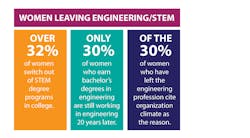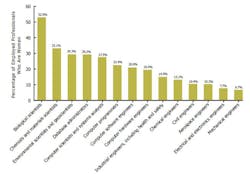This is an exciting time to be in U.S. manufacturing as the industry is experiencing incredible growth, supports 17.6 million jobs, is considered the world’s 9th largest economy, and provides above-average salaries for employees. Yet, any of you reading this article are well-aware of the skills gap problem we are facing in this industry—with more than 2 million jobs expected to go unfilled in the next decade.
And, while women were introduced into the manufacturing workforce with World War I, the U.S. Bureau of Labor Statistics (2014) notes that while women represent nearly half of the total U.S. labor force (47%), they comprise less than a third (27%) of the manufacturing jobs. In nearly 100 years, there has been a meager 8% increase in the number of female employees in the manufacturing industry. Not the kind of stellar advancement anyone would like to see.
The main reasons women end up leaving STEM education paths and professions are due to the organizational climate and lack of mentorship. (Credit: Society of Women Engineers)
Why are there so few women in manufacturing? If the jobs are there, and the pay is great, why aren’t women taking advantage of them? A 2014 Women in Manufacturing report showed that young women, like most people considering future careers, want interesting and challenging work and a high earning potential.
However, the WIM survey found that only 7% of respondents listed manufacturing as a field that offers opportunities for young women. Even worse, 59% said they could not recall a manufacturing company they would consider a leader in attracting and advancing women. Therefore, it is not surprising that 68% of the respondents stated they were not likely to consider manufacturing as a career path.
How can small manufacturers make a difference? Numbers like these show that manufacturing has an obvious perception problem. But what can we do to see real change? Most of us work at companies with fewer than 100 employees, which make up 94% of the manufacturing companies in the U.S. We are struggling to fill the two to three key positions needed to keep our lines moving and products shipping.
As a female president of one of those manufacturing companies, I have worked for years on various national, regional, and local committees to help change some of the alarming skills gap stats. And while that work is important and is helping to make a difference in the big picture, I believe it is up to each individual company to do their part in helping make a change. I encourage all manufacturers, big and small, to help change the perceptions of manufacturing—and in turn increase the number of female employees—by focusing on these five areas:
- Working with educators and parents to differentiate myths from realities
- Serving as mentors and role models
- Providing hands-on experiences
- Showcasing innovation/technology
- Highlighting meaningful work
Educators and Parents: Let’s Talk
Mechanical, chemical, and civil engineering are among the top three engineering degrees earned among women in 2017. (Credit: Society of Women Engineers)
While I talk with high school and college-age students as often as possible, I’ve come to realize that the real target audience needs to be the school staff and parents. Students can be fascinated by the opportunities in manufacturing, but unless they have support from counselors and parents, they will not consider this industry as they make their future plans.
In the 2015 public perception report by Deloitte and The Manufacturing Institute, Americans are reluctant to choose careers in manufacturing, and thus, they aren’t encouraging the next generation to pursue these jobs either. Manufacturing offers a strong career path and multiple benefits without requiring four-year degrees, but many schools focus only on universities and colleges.
While these are clearly great learning institutions, they aren’t the only option. I meet so many students who would be tremendous assets to the manufacturing community but didn’t realize it was even an opportunity. I share with educators and parents the Top 20 Facts list from the National Association of Manufacturers (NAM) as it includes the latest number on salaries, health benefits, and job security, which are all positive.
Mentorships and Role Models
Women in STEM Occupations reported in 2008 show that very few pursue jobs in engineering or manufacturing, focusing on life sciences instead. (Credit: U.S. Department of Labor, Bureau of Labor Statistics)
Mentors are another important factor in bringing in more women to this industry. According to “Why So Few?” by the American Association of University Women in 2010, “Mentorship is often cited as a key strategy for exciting, supporting, and keeping students, young scientists, and engineers in the fields of STEM. This is particularly true for individuals who haven’t historically participated in these areas—such as young women and underrepresented minorities.”
The Million Women Mentor program was developed for “Advancing Women and Girls in STEM Careers Through Mentoring,” and it found that 20% of current female high school students interested in a STEM discipline said they would like to learn more about mentoring and motivational programs to help prepare them for the future.
My fellow females: We are the ones needed to be mentors and role models to this new group of women in manufacturing. We need to take time to answer questions, give guidance, provide real-life answers to their questions, and be visible role models.
Hands-On Experience
Increasing STEM education participation and proficiency for girls starting in elementary school is critical step. Manufacturers must come together to create positive exposure and experiences for women at a young age. When students have some knowledge of the opportunities in manufacturing, their interest in pursuing it as a career rises exponentially. One successful program is the FIRST Robotics Competition, which provides hands-on learning using math and engineering to promote STEM-based learning. According to FIRST statistics, of those who have participated in FIRST:
- They are twice as likely to major in science or engineering
- 33% of girls plan to major in engineering
- More than 75% are in a STEM field as a student or professional
Events like National Manufacturing Day, Junior Achievement job shadowing, career fairs, and more all play a role in showcasing the benefits of manufacturing and providing hands-on, real insight that could change the minds and career paths of a significant number of young women.
Innovation and Technology
Manufacturing in 2018 means technologically advanced machinery and modern buildings designed to help teams of employees collaborate and communicate more easily. It includes use of robotics, 3D printing, artificial intelligence (AI), virtual reality, augmented reality, and the Internet of Things (IoT), just to name a few components. Millennials have been raised with technology as part of every aspect of their lives, and understanding that it plays an important role in manufacturing will help them see this as a more viable career option. From hardware to software and everything in between, the technology advancements in manufacturing are constant and require workers who can keep adapting.
Manufacturing isn’t a career where you check your brain at the door. It needs great problem-solvers who can work to meet current customers’ needs, while also developing new innovations for future concerns. A 2014 Deloitte/The Manufacturing Institute report found that 78% of Millennials said their decision to work at a company was influenced by how innovative they considered the company to be. Don’t miss that number or its importance. The majority of young workers are selecting their future employers based on perceived innovation. Manufacturing is all about innovation—it’s what we do all day, every day.
Meaningful Work
Industries that are the most attractive to women in manufacturing as of 2015. (Credit: Deloitte and the Manufacturing Institute)
Millennials also value the chance to make a difference. Talking with the engineers at my company, they have all said—many times—that what they most love about the manufacturing industry is the ability to take their schooling and innate interests and make a difference by creating something new that can help a customer. This is what we all want and manufacturing has this. We need to be shouting this out much louder!
No matter the size of our manufacturing companies, we can make a difference in the skills gap issue, specifically when it comes to women in this industry. When we focus on sharing the great realities of manufacturing with educators, parents, and students—providing mentorship and role models, as well as hands-on experience—I am confident we will see women hit a true growth stage of impact and influence within this sector. And if we start now, we won’t have to wait another 100 years to enjoy the success women can bring to this industry.





